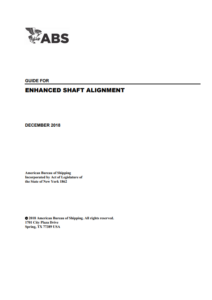ABS published a Guide for ‘Enhanced Shaft Alignment’ to provide direction to owners and operators who are to perform a more detailed shaft alignment analysis and installation assessment. Mainly, the vessels that are designed, built and operated in compliance with the requirements of this guide, may be assigned to Class Notation ESA or ESA+.
Specifically, the assignment of the ESA Notation requires the review of plans and calculations by an ABS Engineering Office in accordance to the ABS Guide for Enhanced Shaft Alignment.
Meanwhile, the assignment of the ESA+ Notation requires the review of plans and calculations by an ABS Engineering Office and compliance with the installation, measurements and sea trials requirements, in accordance to this Guide. This notation additionally requires the attendance of an ABS Surveyor during the shaft alignment operations.
The Guide aims to highlight shafting arrangements as installations with no forward stern tube bearing that may particularly benefit from a more detailed analysis and a more accurate and structured procedure so as to optimize the shaft alignment and improve the service life of the vessel’s powertrain.
The main aspects that distinguish compliance with these Notations from the standard Rule application are:
- For the ESA Notation assignment:
- Shaft alignment optimization calculations are required.
- Compulsory inclusion of hull deflections to be taken into account in the analysis.
- Compulsory inclusion of propeller loads to be taken into account in the analysis.
- Requirement for lateral vibration (whirling) analysis of the powertrain shafting systemin accordance with 2/1.3.5 of this Guide.
- The vessel must be assigned the TCM (Tailshaft Condition Monitoring) Notation.
- For the ESA+ Notation assignment:
-in addition to the above-
- Final sighting is to be conducted after the engine or gearbox and other heavy machinery is installed on board, with superstructure in place, and all major steel works completed at the aft part of the vessel.
- Shaft alignment verification at more than one service condition.
- Sea trials procedures and recordings.
For more information you may click on the PDF herebelow































































